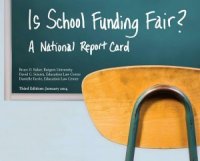 A new report on school funding reveals how uneven and unfair public school funding is in states across the country. The report, titled “Is School Funding Fair? A National Report Card, ” looks at funding data from 2007 through 2011, analyzing the condition of state school finance systems with a focus on the fair distribution of resources to the neediest students. It covers the period before the big 2008 recession and through the start of the recovery. (See chart below)
A new report on school funding reveals how uneven and unfair public school funding is in states across the country. The report, titled “Is School Funding Fair? A National Report Card, ” looks at funding data from 2007 through 2011, analyzing the condition of state school finance systems with a focus on the fair distribution of resources to the neediest students. It covers the period before the big 2008 recession and through the start of the recovery. (See chart below)
The report was written by Bruce Baker, professor in the Department of Educational Theory, Policy and Administration in the Graduate School of Education at Rutgers University; David Sciarra, executive director of the Education Law Center in Newark, N.J., and a practicing civil rights lawyer since 1978; and Danielle Farrie, research director at the Education Law Center. It found, according to the executive summary:
 • Most states have largely stagnant or declining funding levels, and vast disparities among states remain. In fourteen states, funding levels in 2011 were below 2007 levels, even without adjusting for inflation. There is over a $10, 000 gap between the highest funded state (Wyoming) and the lowest (Idaho).
• Most states have largely stagnant or declining funding levels, and vast disparities among states remain. In fourteen states, funding levels in 2011 were below 2007 levels, even without adjusting for inflation. There is over a $10, 000 gap between the highest funded state (Wyoming) and the lowest (Idaho).
• The majority of states have funding systems with “flat” or “regressive” funding distribution patterns that ignore the need for additional funding in high-poverty districts. Recent trends show an increase in the number of regressive states and a decline in the number of progressive states. For example, Utah and New Jersey, both of which previously were among the most progressive states, experienced a significant erosion of equity.
• Most states experienced a decrease in overall revenue resulting in a declining financial base from which to fund schools; most states also further reduced effort by lowering the share of economic productivity dedicated to education. The largest reductions in effort were seen in Maine, Hawaii and Florida.








